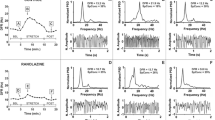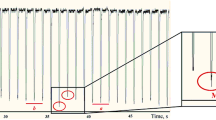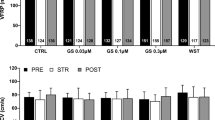Abstract
Background and methods Perturbations in energetic metabolism and impaired atrial contractility may play an important role in the pathogenesis of atrial fibrillation (AF). Besides, atrial stretch is commonly associated with AF. However, the atrial energetics of stretch-related AF are poorly understood. Here, we measured indicators of energy metabolism during acute stretch-related AF. PCr, adenine nucleotides, and derivatives concentrations as well as the activity of the F0F1-ATPase and Na,K-ATPase were obtained after 1 h of stretch and/or AF in isolated rabbit hearts and compared to control hearts without stretch and AF. Results After 1 h of stretch-related AF, the total adenine nucleotides’ pool was significantly lower (42.2 ± 2.6 vs. 63.7 ± 8.3 μmol/g protein in control group, P < 0.05) and the PCr/ATP ratio significantly higher (2.3 ± 0.3 vs. 1.1 ± 0.1 in control group P < 0.05), because of ATP, ADP, and AMP decrease and PCr increase. The sum of high-energy phosphate compounds did not change. There were no significant differences in F0F1-ATPase nor Na,K-ATPase activity between the groups. Conclusions Results show that in this experimental model, acute stretch-related AF induces specific modifications of atrial myocytes energetics that may play a pivotal role in the perpetuation of the arrhythmia.



Similar content being viewed by others
References
Alpert JS, Petersen P, Godtfredsen J (1988) Atrial fibrillation: natural history, complications, and management. Annu Rev Med 39:41–52. doi:10.1146/annurev.me.39.020188.000353
Van Wagoner DR, Nerbonne JM (2000) Molecular basis of electrical remodeling in atrial fibrillation. J Mol Cell Cardiol 32:1101–1117. doi:10.1006/jmcc.2000.1147
Wijffels MC, Kirchhof CJ, Dorland R, Allessie MA (1995) Atrial fibrillation begets atrial fibrillation. A study in awake chronically instrumented goats. Circulation 92:1954–1968
Allessie MA (1998) Atrial electrophysiologic remodeling: another vicious circle? J Cardiovasc Electrophysiol 9:1378–1393. doi:10.1111/j.1540-8167.1998.tb00114.x
Nattel S (1999) Atrial electrophysiological remodeling caused by rapid atrial activation: underlying mechanisms and clinical relevance to atrial fibrillation. Cardiovasc Res 42:298–308. doi:10.1016/S0008-6363(99)00022-X
Thijssen VL, Ausma J, Liu GS, Allessie MA, van Eys GJ, Borgers M (2000) Structural changes of atrial myocardium during chronic atrial fibrillation. Cardiovasc Pathol 9:17–28. doi:10.1016/S1054-8807(99)00038-1
Barbey O, Pierre S, Duran MJ, Sennoune S, Levy S, Maixent JM (2000) Specific up-regulation of mitochondrial F0F1-ATPase activity after short episodes of atrial fibrillation in sheep. J Cardiovasc Electrophysiol 11:432–438. doi:10.1111/j.1540-8167.2000.tb00339.x
White CW, Kerber RE, Weiss HR, Marcus ML (1982) The effects of atrial fibrillation on atrial pressure-volume and flow relationships. Circ Res 51:205–215
Ausma J, Coumans WA, Duimel H, Van der Vusse GJ, Allessie MA, Borgers M (2000) Atrial high energy phosphate content and mitochondrial enzyme activity during chronic atrial fibrillation. Cardiovasc Res 47:788–796. doi:10.1016/S0008-6363(00)00139-5
Cha YM, Dzeja PP, Shen WK, Jahangir A, Hart CY, Terzic A et al (2003) Failing atrial myocardium: energetic deficits accompany structural remodeling and electrical instability. Am J Physiol Heart Circ Physiol 284:H1313–H1320
Leistad E, Aksnes G, Verburg E, Christensen G (1996) Atrial contractile dysfunction after short-term atrial fibrillation is reduced by verapamil but increased by BAY K8644. Circulation 93:1747–1754
Seppet E, Eimre M, Peet N, Paju K, Orlova E, Ress M et al (2005) Compartmentation of energy metabolism in atrial myocardium of patients undergoing cardiac surgery. Mol Cell Biochem 270:49–61. doi:10.1007/s11010-005-3780-y
Mihm MJ, Yu F, Carnes CA, Reiser PJ, McCarthy PM, Van Wagoner DR et al (2001) Impaired myofibrillar energetics and oxidative injury during human atrial fibrillation. Circulation 104:174–180
Tsuboi M, Hisatome I, Morisaki T, Tanaka M, Tomikura Y, Takeda S et al (2001) Mitochondrial DNA deletion associated with the reduction of adenine nucleotides in human atrium and atrial fibrillation. Eur J Clin Invest 31:489–496. doi:10.1046/j.1365-2362.2001.00844.x
Kalifa J, Jalife J, Zaitsev AV, Bagwe S, Warren M, Moreno J et al (2003) Intra-atrial pressure increases rate and organization of waves emanating from the superior pulmonary veins during atrial fibrillation. Circulation 108:668–671. doi:10.1161/01.CIR.0000086979.39843.7B
Bode F, Katchman A, Woosley RL, Franz MR (2000) Gadolinium decreases stretch-induced vulnerability to atrial fibrillation. Circulation 101:2200–2205
Ravelli F, Allessie M (1997) Effects of atrial dilatation on refractory period and vulnerability to atrial fibrillation in the isolated Langendorff-perfused rabbit heart. Circulation 96:1686–1695
Zarse M, Deharo JC, Mast F, Allessie MA (2002) Importance of right and left atrial dilation and linear ablation for perpetuation of sustained atrial fibrillation. J Cardiovasc Electrophysiol 13:164–171. doi:10.1046/j.1540-8167.2002.00164.x
Kalifa J, Bernard M, Gout B, Bril A, Cozma D, Laurent P et al (2007) Anti-arrhythmic effects of I (Na), I (Kr), and combined I (Kr)-I (CaL) blockade in an experimental model of acute stretch-related atrial fibrillation. Cardiovasc Drugs Ther 21:47–53. doi:10.1007/s10557-007-6001-y
Lazzarino G, Di Pierro D, Tavazzi B, Cerroni L, Giardina B (1991) Simultaneous separation of malondialdehyde, ascorbic acid, and adenine nucleotide derivatives from biological samples by ion-pairing high-performance liquid chromatography. Anal Biochem 197:191–196. doi:10.1016/0003-2697(91)90378-7
Desrois M, Sciaky M, Lan C, Cozzone PJ, Bernard M (2003) Preservation of amino acids during long term ischemia and subsequent reflow with supplementation of l-arginine, the nitric oxide precursor, in the rat heart. Amino Acids 24:141–148
Bernard M, Robert K, Caus T, Desrois M, Paganelli F, Cozzone PJ et al (2004) Protective effect of a low K+ cardioplegic solution on myocardial Na,K-ATPase activity. Cell Mol Biol Noisy-le-grand 50:841–844
Gerbi A, Barbey O, Raccah D, Coste T, Jamme I, Nouvelot A et al (1997) Alteration of Na,K-ATPase isoenzymes in diabetic cardiomyopathy: effect of dietary supplementation with fish oil (n-3 fatty acids) in rats. Diabetologia 40:496–505. doi:10.1007/s001250050707
Foussard-Guilbert F, Ermias A, Laget P, Tanguy G, Girault M, Jallet P (1982) Detergent effects of kinetic properties of (Na+ +K+)-ATPase from kidney membranes. Biochim Biophys Acta 692:296–304. doi:10.1016/0005-2736(82)90534-X
Cooper PJ, Lei M, Cheng LX, Kohl P (2000) Selected contribution: axial stretch increases spontaneous pacemaker activity in rabbit isolated sinoatrial node cells. J Appl Physiol 89:2099–2104
Ausma J, Wijffels M, Thone F, Wouters L, Allessie M, Borgers M (1997) Structural changes of atrial myocardium due to sustained atrial fibrillation in the goat. Circulation 96:3157–3163
Power JM, Beacom GA, Alferness CA, Raman J, Farish SJ, Tonkin AM (1998) Effects of left atrial dilatation on the endocardial atrial defibrillation threshold: a study in an ovine model of pacing induced dilated cardiomyopathy. Pacing Clin Electrophysiol 21:1595–1600. doi:10.1111/j.1540-8159.1998.tb00248.x
Bittl JA, Ingwall JS (1986) The energetics of myocardial stretch. Creatine kinase flux and oxygen consumption in the noncontracting rat heart. Circ Res 58:378–383
Bak MI, Ingwall JS (1994) Acidosis during ischemia promotes adenosine triphosphate resynthesis in postischemic rat heart. In vivo regulation of 5′-nucleotidase. J Clin Invest 93:40–49. doi:10.1172/JCI116974
Bernauer W (1994) Release of adenine nucleotide metabolites by toxic concentrations of cardiac glycosides. Basic Res Cardiol 89:308–321
Straeter-Knowlen IM, Butterworth EJ, Buchthal SD, Hollander JA, Caulfield JB, Jennings RB et al (2002) PCr overshoot: a study of the duration in canine myocardium. NMR Biomed 15:52–59. doi:10.1002/nbm.757
Kalil-Filho R, Gerstenblith G, Hansford RG, Chacko VP, Vandegaer K, Weiss RG (1991) Regulation of myocardial glycogenolysis during post-ischemic reperfusion. J Mol Cell Cardiol 23:1467–1479. doi:10.1016/0022-2828(91)90192-O
Songu-Mize E, Sevieux N, Liu X, Jacobs M (2001) Effect of short-term cyclic stretch on sodium pump activity in aortic smooth muscle cells. Am J Physiol Heart Circ Physiol 281:H2072–H2078
Ohkusa T, Ueyama T, Yamada J, Yano M, Fujumura Y, Esato K et al (1999) Alterations in cardiac sarcoplasmic reticulum Ca2+ regulatory proteins in the atrial tissue of patients with chronic atrial fibrillation. J Am Coll Cardiol 34:255–263. doi:10.1016/S0735-1097(99)00169-2
El-Armouche A, Boknik P, Eschenhagen T, Carrier L, Knaut M, Ravens U et al (2006) Molecular determinants of altered Ca2+ handling in human chronic atrial fibrillation. Circulation 114:670–680. doi:10.1161/CIRCULATIONAHA.106.636845
Xie Z (2001) Ouabain interaction with cardiac Na/K-ATPase reveals that the enzyme can act as a pump and as a signal transducer. Cell Mol Biol Noisy-le-grand 47:383–390
Liu L, Askari A (2006) On the importance and mechanism of amplification of digitalis signal through Na+/K+-ATPase. Cell Mol Biol Noisy-le-grand 52:28–30
Klein HO, Bakst A, Kaplinsky E (1988) Pulmonary embolism and atrial fibrillation. Am J Cardiol 61:498–499. doi:10.1016/0002-9149(88)90326-8
Lai LP, Su MJ, Lin JL, Lin FY, Tsai CH, Chen YS et al (1999) Down-regulation of L-type calcium channel and sarcoplasmic reticular Ca(2+)-ATPase mRNA in human atrial fibrillation without significant change in the mRNA of ryanodine receptor, calsequestrin and phospholamban: an insight into the mechanism of atrial electrical remodeling. J Am Coll Cardiol 33:1231–1237. doi:10.1016/S0735-1097(99)00008-X
Yue L, Feng J, Gaspo R, Li GR, Wang Z, Nattel S (1997) Ionic remodeling underlying action potential changes in a canine model of atrial fibrillation. Circ Res 81:512–525
Ban K, Handa S, Chapman RA (1999) On the mechanism of the failure of mitochondrial function in isolated guinea-pig myocytes subjected to a Ca2+ overload. Cardiovasc Res 44:556–567. doi:10.1016/S0008-6363(99)00233-3
Sadoshima J, Jahn L, Takahashi T, Kulik TJ, Izumo S (1992) Molecular characterization of the stretch-induced adaptation of cultured cardiac cells. An in vitro model of load-induced cardiac hypertrophy. J Biol Chem 267:10551–10560
Acknowledgments
The authors would like to thank CNRS (UMR 6612) for their support. J. Kalifa was supported by grants ADEREM Marseille, NIH RO1 087055-01, and ACCF/GE Healthcare Career Development Award.
Author information
Authors and Affiliations
Corresponding author
Rights and permissions
About this article
Cite this article
Kalifa, J., Maixent, JM., Chalvidan, T. et al. Energetic metabolism during acute stretch-related atrial fibrillation. Mol Cell Biochem 317, 69–75 (2008). https://doi.org/10.1007/s11010-008-9832-3
Received:
Accepted:
Published:
Issue Date:
DOI: https://doi.org/10.1007/s11010-008-9832-3




